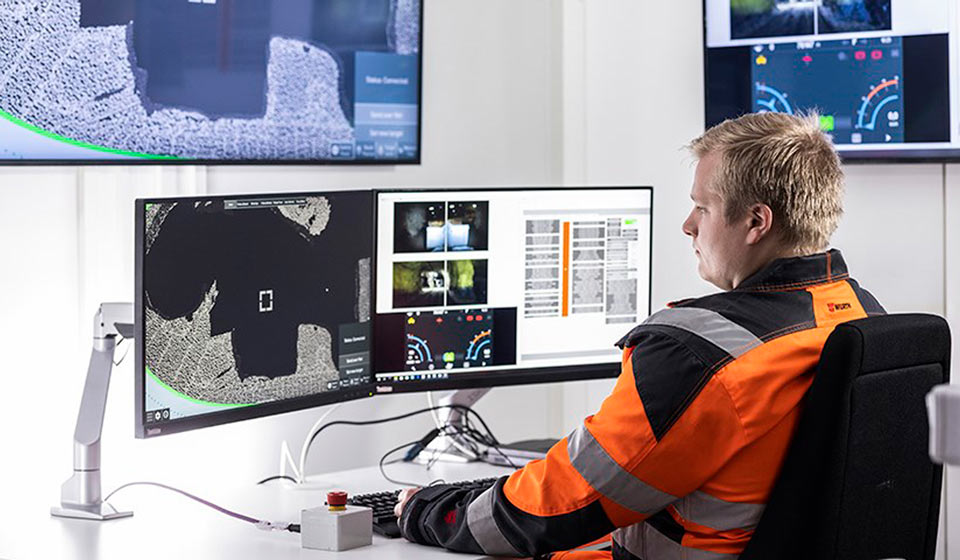
FinMeas involved in performing measurements for the demanding excavations associated with the West Metro.
Remote monitoring eases measurements at the West Metro construction site
FinMeas was involved in performing measurements for the demanding excavations associated with the West Metro in Espoo. The new Urheilupuisto metro station next to the Esport Center was entirely built as an open excavation project. It is the only station of its kind where this has been done. The varied soil types brought additional challenges.
FinMeas technology was used at the Urheilupuisto metro station to measure the anchor force of retaining walls, soil displacements and rock movements. All of the measurements were commissioned by Ramboll Finland acting as a subconsultant for Sweco.
Pasi Kolomainen, who was in charge of rock mechanical monitoring for the West Metro project and ground investigations at Ramboll Finland, particularly appreciated the automatic remote monitoring feature of FinMeas measuring devices. This feature saves time and effort during manual measurements. In addition, automatic measurements enable the more accurate identification of when changes occur.
“FinMeas’ remotely readable measurement devices represent an entirely new concept compared to traditional methods. It is much easier and more efficient to monitor measurement results directly from an online user interface rather than check manual measurement equipment on site on a weekly basis,” says Kolomainen.
In addition, measurement devices used in highly demanding construction projects such as metro tunnels can be located in relatively inaccessible places. Under such circumstances, measurement devices that can be read remotely are an unbeatable option. These too can be installed in fairly inaccessible locations.
The pit for the Urheilupuisto metro station was entirely built using the open excavation method. It is more than 20 metres deep, in an area with a great deal of soft ground. Located right next to the pit is the Esport Center sports hall, which continued to operate normally throughout the construction period.
Four FinMeas automatic inclinometers measured movements in the ground structure between Esport Centre and the pit. Only a few metres separate the sports hall from the pit, and onsite traffic was busy in some places.
However, measurements of anchor forces ensured that the pit was sufficiently propped. Support structures could be dimensioned properly, saving costs and improving safety.
“Measurements of anchor forces and movements played an important role in the monitoring of site safety,” Kolomainen explains.
Under the FinMeas system, inclinometer measurement rods are inserted into the soil, and measurement data is transmitted wirelessly to an intuitive online service. The operator can set alarm limits: if these are exceeded, he or she is informed in real time by e-mail or text message. Automatic monitoring is more reliable and economical than traditional methods.
FinMeas inclinometers were also used for rock mechanical monitoring. Kolomainen cannot recall a similar case in which automatic inclinometers were installed in rock. The challenge lies in the fact that the measuring devices have to be installed as close as possible to the surface being excavated, otherwise they will not provide sufficiently accurate information.
“We installed the inclinometers one or two metres from the excavation line. The devices withstood the considerable forces and impetus caused by the explosion. Although there is still some room for developing the use of inclinometers in rock mechanical measurements, FinMeas has been highly proactive in this regard.”
Kolomainen believes that FinMeas measuring devices have the edge over competing devices by allowing the measurement interval to be changed flexibly in line with the phase of construction. During the excavation, measurements were performed as frequently as every 12 hours. Overall, rock mechanical movements were monitored for a couple of months after the completion of the excavations.
“More frequent measurements enable the more precise linkage of potential changes to the time of blasting and, for example, to the explosives used. Similarly, we can easily select the measurements we want online – monitoring is very smooth.”
Rock mechanical monitoring for the West Metro has focused on station halls. These halls were modelled on the basis of ground investigations: the expected movements and directions of the rock were calculated in advance. Preliminary calculations can be verified using measurement results, enabling a response to deviations at the earliest possible stage. In the case of the West Metro metro stations, for example, it was known beforehand that the type of stone at the Matinkylä metro station would be demanding – the results confirmed that reinforcement work was required at the station.
Since completing his work on the West Metro, Kolomainen moved on to the ground investigations under planning for the Pisara line. Blasting there, too, will be exceptionally demanding, as the line passes under parts of central Helsinki. This means that measurements will also be important in this case.
Kolomainen believes that, thanks to their ease of use, the remotely readable measurement devices used at the West Metro’s Urheilupuisto metro station will be adopted more widely in the future – in railway line projects and many other construction projects of a demanding nature. In addition to FinMeas’ easy-to-use measurement devices, Kolomainen praises the company’s attitude to service.
“Cooperation with FinMeas has gone well, and communication has been active. They understand the needs of engineers and builders and are proactive if they notice any deviations in measurement results.”
FinMeas automatic inclinometers and anchor force measurements were used as a solution in this project.

